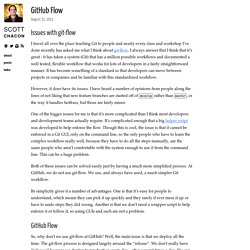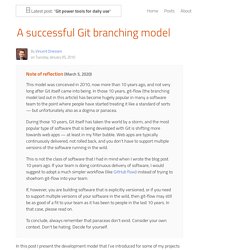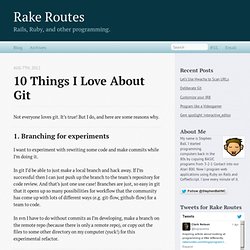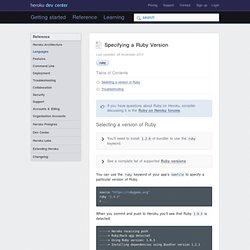

Flynn - Open source Platform as a Service powered by Docker. GitHub Flow – Scott Chacon. August 31, 2011 Issues with git-flow I travel all over the place teaching Git to people and nearly every class and workshop I’ve done recently has asked me what I think about git-flow.

I always answer that I think that it’s great - it has taken a system (Git) that has a million possible workflows and documented a well tested, flexible workflow that works for lots of developers in a fairly straightforward manner. It has become something of a standard so that developers can move between projects or companies and be familiar with this standardized workflow. However, it does have its issues. One of the bigger issues for me is that it’s more complicated than I think most developers and development teams actually require. Both of these issues can be solved easily just by having a much more simplified process.
Its simplicity gives it a number of advantages. GitHub Flow So, why don’t we use git-flow at GitHub? There are a number of advantages to deploying so regularly. How We Do It Conclusion. A successful Git branching model » nvie.com. Note of reflection (March 5, 2020)This model was conceived in 2010, now more than 10 years ago, and not very long after Git itself came into being.

In those 10 years, git-flow (the branching model laid out in this article) has become hugely popular in many a software team to the point where people have started treating it like a standard of sorts — but unfortunately also as a dogma or panacea.During those 10 years, Git itself has taken the world by a storm, and the most popular type of software that is being developed with Git is shifting more towards web apps — at least in my filter bubble. Web apps are typically continuously delivered, not rolled back, and you don't have to support multiple versions of the software running in the wild.This is not the class of software that I had in mind when I wrote the blog post 10 years ago. RVM workflow for a new Rails app. 10 things I love about git.
Not everyone loves git.

It’s true! But I do, and here are some reasons why. 1. Branching for experiments I want to experiment with rewriting some code and make commits while I’m doing it. In git I’d be able to just make a local branch and hack away. In svn I have to do without commits as I’m developing, make a branch on the remote repo (because there is only a remote repo), or copy out the files to some other directory on my computer (yuck!) 2. Oh no! In git I have a staging area to serve as an intermediate place for code that I’m ready to commit up to the public repository. In svn there is no concept of partial commits. EDIT: Ha, no. EDIT 2: Aw man. AWESOME: Molecule on Hacker News explained git add –edit, which I had never heard of. git add --edit opens an individual file or all of your changes in a single diff (like you would see in git diff) that you can edit. 3. Git not only allows me to easily experiment with the code; it allows me to experiment with the repo itself.
Ruby on rails - git push heroku master error Permission denied (publickey) Intermediate Git. Git - rejected master -> master (non-fast-forward) Dealing with non-fast-forward errors. Github - Error Remote Origin Already Exists on Git Push to New Repository. Git push heroku master Permission denied (publickey). fatal: The remote end hung up unexpectedly. Specifying a Ruby Version. Ruby Table of Contents Selecting a version of Ruby You’ll need to install 1.2.0 of bundler to use the ruby keyword.

You can use the ruby keyword of your app’s Gemfile to specify a particular version of Ruby. source " ruby "1.9.3" When you commit and push to Heroku you’ll see that Ruby 1.9.3 is detected: -----> Heroku receiving push -----> Ruby/Rack app detected -----> Using Ruby version: 1.9.3 -----> Installing dependencies using Bundler version 1.2.1 ... For specifying non MRI ruby engines, you’ll need to use the :engine and :engine_version options. Ruby "1.9.3", :engine => "jruby", :engine_version => "1.7.8" Please see Ruby Support for a list of available versions. If you were previously using RUBY_VERSION to select a version of Ruby, please follow the instructions above to specify your desired version of Ruby using Bundler. Troubleshooting Migration Applications that migrate to a non-default version of Ruby should have bin be the first entry in their PATH config var.
Bundler.